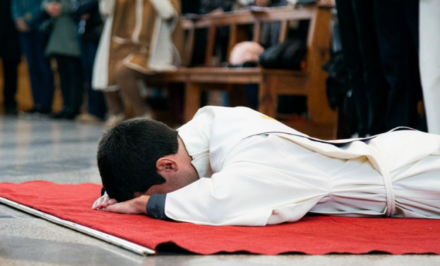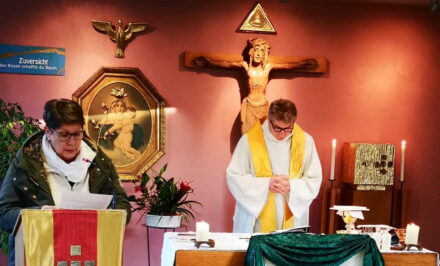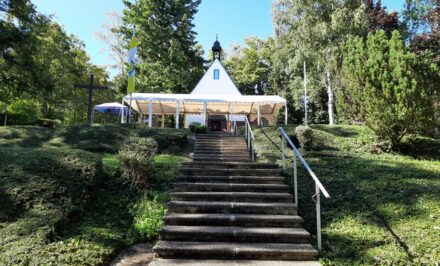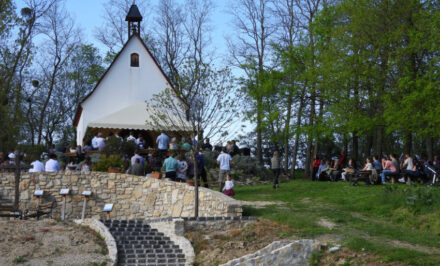 ROME, Sister Johanna-Maria Helmich. The days of October 15th and 16th, 2011, will surely be registered in the chronicles of Rome. First, from the viewpoint of the demonstrations and the tumult, which were caused by the manifestations against power and the excess of the financial economy, Rome was among at least 950 cities from 82 cities that were among the first on the level of violence. But looking even deeper, there is another event that made history: it was the first Congress of the New Evangelization, prepared by the Pontifical Council for the New Evangelization, for the representatives of the new evangelization and the ecclesial movements. Pope Benedict XVI honored the Congress twice with his visit, and through this he gave important momentum: On Saturday afternoon, with 8,500 representatives of the Church’s movements and on Sunday morning, during the Holy Mass at Saint Peter’s Basilica with the same participants.
ROME, Sister Johanna-Maria Helmich. The days of October 15th and 16th, 2011, will surely be registered in the chronicles of Rome. First, from the viewpoint of the demonstrations and the tumult, which were caused by the manifestations against power and the excess of the financial economy, Rome was among at least 950 cities from 82 cities that were among the first on the level of violence. But looking even deeper, there is another event that made history: it was the first Congress of the New Evangelization, prepared by the Pontifical Council for the New Evangelization, for the representatives of the new evangelization and the ecclesial movements. Pope Benedict XVI honored the Congress twice with his visit, and through this he gave important momentum: On Saturday afternoon, with 8,500 representatives of the Church’s movements and on Sunday morning, during the Holy Mass at Saint Peter’s Basilica with the same participants.
Europe is in flames! Isn’t it? The market and capital economy is ablaze-one fire after another. In this context, doesn’t the Congress for the New Evangelization appear to be building a fictional world? No, it is not about a fictional world; rather, it is a fireproof wall against the fire that is spreading rapidly in our society: it is the fire of the Holy Spirit.
The new evangelization has been in the heart of the Schoenstatt apostolic movement since the beginning. That is how it understands itself, so Schoenstatt had to be present at this Roman Congress.
Schoenstatt missionaries
 On Saturday morning, Father Heinrich Walter, Ángel Sevillano and his spouse Teresa Mazón, from Madrid, and Sister Johanna María were among the approximately 380, who participated in the Congress. The Archbishop of Frieburg, Robert Zollitsch, was another Schoenstatter, who was present in his function as a member of the Pontifical Council for the New Evangelization.
On Saturday morning, Father Heinrich Walter, Ángel Sevillano and his spouse Teresa Mazón, from Madrid, and Sister Johanna María were among the approximately 380, who participated in the Congress. The Archbishop of Frieburg, Robert Zollitsch, was another Schoenstatter, who was present in his function as a member of the Pontifical Council for the New Evangelization.
On Saturday afternoon and on Sunday morning, thirteen German missionaries of the Schoenstatt Rosary Campaign and 150 Italian Schoenstatters also attended. (Gian Francesco Romano has already reported about the program on Saturday afternoon in the Paul VI Hall).
Reflections about the new evangelization
 One hundred fifteen communities and groups registered for this initial experience in Rome. Approximately two to four delegates from each one were able to participate intensely in the meeting in the Synod Hall. Just 440 people gathered there, who were invited by Bishop Rino Fisichella, president of the new discastery.
One hundred fifteen communities and groups registered for this initial experience in Rome. Approximately two to four delegates from each one were able to participate intensely in the meeting in the Synod Hall. Just 440 people gathered there, who were invited by Bishop Rino Fisichella, president of the new discastery.
Many ideas and reflections were presented about the new evangelization with simultaneous translation in five languages, so that everyone would have access.
Life always seeks new roads, and it needs an adequate response to the new challenges of the secular crisis of our era, as Bishop Fisichella stressed in his introductory talk, referring to Pope Benedict XVI. In any case, it is a fundamental requisite for the transmission of the faith, that one transforms him/herself through grace. Saint Augustine demonstrates this process in a magnificent image when interpreting the text about the healing of the paralytic who was lowered from the roof before Jesus: It is valid to raise the roof to take paralytic souls to the Lord. Evangelization can only take effect when the paralysis of the soul disappears. The new evangelization can be like a river that waters different fields. Previously the participants had been informed about which fields in our era needed the water of life. The seven areas presented were: culture, migration, communication, family, liturgy, politics, and regular pastorate. These fields were explained by the representatives from the different movements, who gave testimony of how their charism was trained precisely for apostolic action in these areas.
But it was not only these movements that gave their support; there was truly an agglomeration at the end in the complementary exchange to what they heard. Each exchange had to be presented in writing, and only those, who were called by name, could speak for exactly three minutes. With this strict regulation there were nineteen contributions.
The second exchange was announced: Teresa Mazón, who was introduced as belonging to the Schoenstatt Movement.
The Homeshrine: an instrument of evangelization
 Teresa Mazón, referred to the family atmosphere: the parents are the first evangelizers. They have the task of demonstrating that marriage is the road and that there are no other alternatives offered today in place of marriage and the family. Parents are the first witnesses of the Faith for their children. It is precisely here that Schoenstatt can offer something of itself to the Church: the Home shrine as an instrument of evangelization. It is a place of prayer in the home, where Mary can act as Mother and educator. In this way, the entire family is evangelized and then can be an instrument of evangelization.
Teresa Mazón, referred to the family atmosphere: the parents are the first evangelizers. They have the task of demonstrating that marriage is the road and that there are no other alternatives offered today in place of marriage and the family. Parents are the first witnesses of the Faith for their children. It is precisely here that Schoenstatt can offer something of itself to the Church: the Home shrine as an instrument of evangelization. It is a place of prayer in the home, where Mary can act as Mother and educator. In this way, the entire family is evangelized and then can be an instrument of evangelization.
Holy Mass at Saint Peter’s Basilica
 The highlight and closing of the Congress was the celebration of the Holy Mass “for the new evangelization” with the Holy Father on Sunday morning in the Basilica of Saint Peter’s. A new formula for the Holy Mass had been prepared for this occasion. It was a great gift to see the Holy Father closely since he entered crossing the Basilica.
The highlight and closing of the Congress was the celebration of the Holy Mass “for the new evangelization” with the Holy Father on Sunday morning in the Basilica of Saint Peter’s. A new formula for the Holy Mass had been prepared for this occasion. It was a great gift to see the Holy Father closely since he entered crossing the Basilica.
Father Heinrich Walter and Father Ludovico Tedeschi, from Rome, were among the con-celebrants. Within the several the possibilities of participating in this Eucharist, Schoenstatt had a special honor since three Sisters of Mary were chosen to represent the people of God in the presentation of the offerings to the Pope. They carried the chalice and the paten, and after this beautiful procession of offerings, they presented them to the Holy Father. He touched the paten, he asked where the Sisters were from and later they manifested their experience of his: “kindness and sincerity in person.”
The intention of this Eucharist was to allow oneself to be sent forth by the Holy Father to the New Evangelization. It was also the desire of the Schoenstatters present that they would serve the Church in being commissioned by the Church and for its fruitfulness.
And it was this desire that was precisely carried out: “we, as ‘protagonists of the new evangelization’ and with the ‘enthusiasm of the first Christians’ as the Pope Benedict XVI expressed it, could receive the solemn blessing at the conclusion of the Holy Mass as those sent forth, with our gazes and hearts directed to Mary, just as we had learned from Father Kentenich, and also as they placed us before the view of the Holy Father, as a model of the new evangelization,” commented one of the participants.
The Holy Father’s words after the Angelus touched the German participants deeply:
“We are also called to live our faith in words and deeds, and in this way to be presenters of the Gospel and missionaries in daily life. God counts on our collaboration, and he counts our testimonies of faith. May the Lord give us the gifts of the Holy Spirit for this.”
See also:
Celina M. Garza: Spanish/English translation – Melissa Peña-Janknegt: English edit













